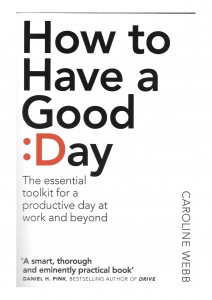The one sentence summary
It is possible to have fulfilling and productive days when you understand the psychology and neuroscience behind how people behave. 
WHAT THE BOOK SAYS
- This book outlines the science essentials that explain how people behave, looks at priorities and productivity, relationships and thinking, along with resilience and energy. This involves:
- Set intentional direction for your day: choose filters for aim, attitudes, assumptions and attention, set yourself better goals.
- Make the hours in the day go further: multitasking doesn’t work – use singletasking instead; batch your tasks, zone your day, remove distractions, plan deliberate downtime, make decisions at peaks, not troughs, allow reflection time; automate the small stuff if possible, or turn it into a simple routine.
- Make the most of every interaction: build real rapport, resolve tensions and bring the best out of others; don’t demean others by assuming that they “don’t get it” – you may be missing something; ask quality questions and listen properly; ditch your device and pay attention.
- Be your smartest, wisest, most creative self: switch views and look for analogies; beware the Einstellung Effect, where having an existing solution in mind makes it harder for us to see a radically different but better way to solve the problem.
- Maximize the impact of all you say and do.
- Sail through setbacks and annoyances, and reframe nerves as excitement.
- Boost your enthusiasm and enjoyment, get some distance, and play to your strengths.
WHAT’S GOOD ABOUT IT
- Mental contrasting: what’s most likely to get in the way? What is your when-then plan? (When x happens, then I will do y).
- Avoid absolute language such as it’s a total disaster, that is completely Things are usually more subtle than that.
- Productivity summarized in 11 words: One thing at a time. Most important thing first. Start now.
- “What I like about this…” is a good way to encourage people, possibly followed by “What would make me like it even more is…”
- A dilemma has two premises – two valid courses of action that are so different they are hard to compare. To resolve one, What could I do? is a better question than What should I do?
- When it comes to email, OHIO: only handle it once.
WHAT YOU HAVE TO WATCH
- Students of behavioural economics will have seen most of this before, but if not it’s good to have it all in one place.
